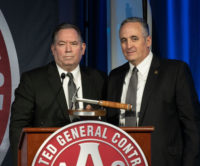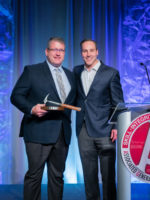Industry Associations
AGC Utah Members Optimistic in a Market That Has Peaked But Remains Strong

Marking the leadership transition at AGC Utah’s annual convention are (from left) Doug Welling, the association’s incoming chairman, and the president and CEO of Jacobsen Construction; Michael Kurz, 2017 chairman, with Staker Parson Cos.; and Rich Thorn, chapter president.
Photo by Brian Fryer
While record earnings may be in the rearview mirror for many Utah contractors, plenty of work is still ahead and general optimism and confidence abound among members of the Associated General Contractors of Utah Chapter. That is the consensus of a statewide forecast from a well-known Utah economist, as AGC members gathered to install new leadership and attend development workshops at the chapter’s 96th annual convention on Jan. 18–20 in Salt Lake City.
“Our members are excited. It’s a good time to be a contractor in Utah. Most of them are coming off record years, and we’re looking forward to a good 2018,” said Rich Thorn, AGC of Utah president.
The association held an awards ceremony and economic forecast on the first day of the convention and closed on the 20th with 2017 Board Chairman Michael Kurz, president of Staker Parson Cos.’ Utah and Arizona operations, handing the 2018 chapter leadership over to Doug Welling, president and CEO of Jacobsen Construction.
“It has been a very humbling experience for me the past year, and I’ve learned a lot visiting members around the state and seen what a truly world-class association we have here,” Kurz said.
Membership totals remain steady at 500 to 525 firms, according to Thorn who, along with Kurz and other chapter leaders, accepted the J. Howard Mock award for membership growth and retention last October from national AGC.
“It was great to go accept that award and check in with our Utah representatives in Washington, D.C.,” said Thorn. He noted that the chapter’s efforts on behalf of workforce development and recruiting have moved into the implementation phase in the past year.
Local AGC leaders met with 1,200 guidance counselors, and member firms are “adopting” a local school to provide a personal connection to the construction industry. “In the last year, we’ve also partnered with the ‘I Build America’ organization to establish a local presence, with two websites and information about working in our industry,” Thorn said.
Welling said that in the coming year he hopes to sustain the workforce-development momentum. “We can’t ever get complacent about that. As employers, we are asking people to come work for us, and it is imperative that they can do that safely,” he said. “I’m hoping we’ll also get more people to participate with the association and get involved in committees so we can make the industry better for everyone.”
Welling said he also hopes to diversify the industry’s workforce as it grows.
“We need everyone. And we need to reach out to women and to the Latino and the Polynesian and other communities and let them know this is a safe industry where you can make a difference,” Welling added. “I hope we’ll also get other groups talking to us so that when issues that come up that can affect our industry, we can have input on it early on.”
Work Still to Be Done
Jeff Clyde, president of heavy/civil construction firm W.W. Clyde, said that while revenues were down slightly from the highs of 2016, the firm was very busy in the past year and has a strong backlog going into 2018.
“Our volume was down a little last year. We finished a new runway at the Vernal airport last year and started some projects that will carry into this year,” he said. “We started a CM-GC project for UDOT doing work on Redwood Road and we’re doing work for Pacific Corp. (an Oregon-based electrical utility company that serves Utah) to close down their Cottonwood coal mine in Emery County (in central Utah) to seal up the portals and some other work there. We also started our joint venture with Ralph L. Wadsworth on four new overpasses on the Bangerter Highway that will carry over to this year.”
Tod Wadsworth, president of Ralph L. Wadsworth Construction Co., said volumes were also down slightly in 2017 compared to previous years. “It wasn’t a record year for us, but close,” said Wadsworth. “We finished work on I-215 (repaving, realignment, bridge replacement) This year, we’ll be continuing the Bangerter Highway work and going to start a project for UDOT on the southbound lanes of I-15. We’ll be doing some accelerated bridge replacement on that job.”
The slightly lower volumes last year didn’t dampen the spirits of Slade Opheikens, president and CEO of Ogden-based R&O Construction, which earned the Contractor of the Year award from the Utah Division of Facilities Construction and Management.
“We started targeting becoming a DFCM-qualified contractor back in 2006, and for a while, we didn’t know if we’d ever make it. We are a smaller contactor going up against the biggest four and five contractors in the state who have been doing it a long time,” he said.
“A few years ago, there were changes on how they (DFCM) did the bidding process, and it was for the Utah State University campus in Brigham City. Our team really dug in and worked with our subs and did everything we could, and won that project, and we knew we had to do a great job on it. It went well and now it has led to several more projects with the state,” Opheikens said.
“That award doesn’t just happen,” said Thorn. “It takes a lot of hard work and sweat and tears.”
DFCM Director Jim Russell accepted “DFCM Employee of the Year” honors from the association. Russell thanked AGC members for their quality work and noted that his department will oversee a budget of about $3 billion this year.
Continued Moderate Growth
During an economic forecast, Natalie Gochnour, director of the Kem C. Gardner Policy Institute at the University of Utah and chief economist for the Salt Lake Chamber, said that growth in construction and other sectors has likely peaked but would remain healthy, fueled by the reform of federal regulations, a soaring stock market and recently passed changes to the federal tax code.
“We have strong wage growth and strong in-migration in Utah and the construction at Salt Lake International Airport is the gift that keeps on giving for contractors,” said Gochnour. “But there is a contrast, because we also have rising interest rates, rising costs, and here in Utah, we have air-quality concerns that can affect our growth.”
The $3-billion replacement of the terminal at Salt Lake City Airport has been financed entirely through fees generated at the airport and not by increased taxes. The construction is being done by HDJV, a joint venture of Salt Lake City-based Big-D Construction and Atlanta-based Holder Construction. It is scheduled for completion in 2025.
West of the airport, sitework continues on Utah’s other largest and most visible project, the new state prison. The $550-million project is being managed by a joint partnership of Big-D and Kitchell Construction of Phoenix and is slated for completion in 2020.
Gochnour said that for several years Utah had been trending ahead of national numbers in terms of jobs recovered after the 2008 recession.
“We have been growing at about 2.9%, while nationally it has been 1.4%,” she said. “We also have very low unemployment, which is good, but also makes it tougher to find workers for your industry.”
Gochnour said that before the federal tax cut passed at the end of 2017, economists were expecting three federal-interest rate hikes, but now anticipate as many as four within the next year.
“That will raise the cost of capital and have some downward pressure on growth,” she said. “You have a real contrast with fiscal policy putting more money out there to keep growth going with tax reform and then monetary policy trying to slow things down.”
Gochnour noted that while wages have been mostly stagnant during the growth years, they have started to increase.
“But in Utah, we have rising costs for housing, land costs, interest rates, and they will start to slow us a bit,” she said.
Thorn said that with the start of the Utah Legislative session after the convention, the chapter will be monitoring bills that may increase costs or affect the performance of the construction market, but AGC Utah does not currently support or oppose any particular bills, as in past years.
“We’re always watching developments on the hill,” he said. “Right now, there is talk about a bill that would allow cities to impose higher taxes on gravel pits and those aggregate operations, but we’re going to keep our eye on that as the session moves along.”


